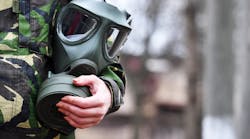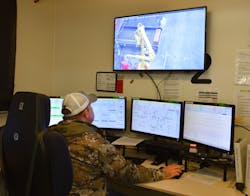After eight years and more than 780,000 projectiles, the U.S. Army Pueblo Chemical Depot has destroyed the final munition in its chemical weapons stockpile.
Since starting operations in March 2015, the Colorado-based depot has processed more than 2,613 tons of chemical weapons in its chemical agent-destruction pilot plant (PCAPP). These include 155-mm and 105-mm projectiles and 4.2-in. mortar rounds containing a mustard agent.
The projectiles and a portion of the mortar rounds were destroyed in the main plant under the supervision of trained operators using automated technology beginning in September 2016.
The mustard agent was neutralized; its byproduct, a hydrolysate, was broken down into salt, water and organics using a biotreatment process.
Projectiles deemed unsuitable for automated processing, plus the remaining mortar rounds, were destroyed in static detonation chambers (SDCs).
Earlier, 951 problematic projectiles were demolished using an explosive destruction system.
Engineers from Bechtel Defense and Space in Reston, Virginia, led the effort. The United States is now nearing its commitment to destroy all chemical weapons by Sept. 30.
The Blue Grass Army Depot, based in Richmond, Kentucky, is destroying the remainder of the original 30,000-ton stockpile. Also led by Bechtel, operations are expected to finish shortly.
As of June 2023, the Blue Grass chemical agent-destruction pilot plant (BGCAPP) had destroyed more than 496 tons of the depot’s remaining 523 tons of munitions.
These include the GB and VX chemical weapon delivery systems. After draining the agent, the warheads were placed in containers and stored in igloos at the depot. They will be destroyed in an SDC unit later. Rocket motors will be shipped to Anniston, Alabama, where they will be destroyed in an SDC facility.
Once operations are complete at the Kentucky site, both the PCAPP and BGCAPP will be decontaminated and dismantled.
Meanwhile, in May, the Organization for the Prohibition of Chemical Weapons (OPCW), based in the Hague, the Netherlands, inaugurated its new €34-million (US$37-million) Centre for Chemistry and Technology (CCT).
The plan is to consolidate some of the organization’s existing laboratories onto one site and add new monitoring and training programs.
The new center’s warehouse contains analytical equipment ready to be dispatched around the world.
The OPCW investigates alleged chemical weapons attacks and sends inspectors to chemical facilities in member countries, often at short notice, to search for evidence of the production of banned chemicals.
“The centre will allow the OPCW to enhance the [lab] verification regime through maintaining and developing our knowledge, skills and expertise related to chemical weapons,” said OPCW director-general Fernando Arias at its opening.
The new facilities are part of a network of 25 OPCW-designated labs. The remit of the CCT includes putting these labs through a periodic certification process to renew participation in the network. The CCT also trains chemists from labs that want to match its standards and join the list.
To provide knowledge to as many nations as possible, the OPCW is working on certifying labs in African countries for the first time: current trainees include scientists from Algeria, Morocco, Kenya, Nigeria and South Africa.
Although most countries (except Egypt, Israel, North Korea and South Sudan) have officially renounced the use of chemical weapons under the Chemical Weapons Convention (CWC) international treaty, such chemicals continue to be used illegally.
The OPCW believes it has played a central part in response to crises. For example, its investigators found that nerve gas and chlorine were used in the Syrian civil war. In 2018, an OPCW team investigated the attempted assassination of a Russian dissident in the U.K. that involved a nerve agent called Novichok.
Former Russian military officer Sergei Skripal, his daughter Yulia and police officer Nick Bailey survived after being hospitalized in critical condition following the attack.
However, there was no response to a Chemical Processing query about exactly what the OPCW’s new monitoring and training programs will involve, what type of analytical and other equipment is contained in the crates at the CCT, or if the organization itself is involved in work to develop new detection and disposal methods for chemical weapons.




